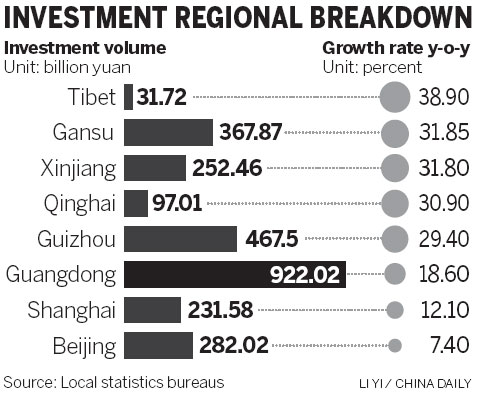Provinces' investment outpaces national average
Updated: 2013-08-20 07:48
By Zheng Yangpeng (China Daily)
|
||||||||
The investment of most provinces in the first half of the year outpaced the national average of 20.1 percent, but general momentum slowed down compared with the same period last year.
All of the 31 provinces, municipalities and autonomous regions across the mainland have released their investment data calculated by local statistics bureaus. Twenty-three have beaten the national average, with the highest growth rate of 38.9 percent seen in the Tibet autonomous region.
The combined fixed-asset investment, a key pillar of China's local economy, was 909.9 billion yuan ($148.6 billion) more than the national total released by National Bureau of Statistics, or equivalent of Guangdong province's fixed-asset investment in the first half of the year.
However, compared with the first half of last year, the growth has generally slowed. In southwest Guizhou province, investment growth fell to 29.4 percent from a sizzling 60 percent a year ago, while in central Anhui province, growth eased to 21.6 percent from 22.8 percent a year earlier.
This is in line with the national trend. China's fixed-asset investment growth in the first half eased to 20.1 percent to hit 18.13 trillion yuan, down from 20.4 percent a year earlier.
"The investment-led rebound has not happened. This is due to a number of reasons, including weakness in global demand and tight restrictions on the property market. Investment in public utilities will partially offset the slowdown, but investment overall is expected to contribute less to growth," said Fred Gibson, an associate economist with Moody's Analytics.
Fixed-asset investment growth in the first seven months was at 20.1 percent, according to NBS data.
Investment in eastern regions grew 18.7 percent, while it grew 22.7 percent in western regions in the January to July period, similar to the growth seen in the January to June period. The investment growth in central regions decreased 0.1 percentage point to 23.5 percent in the January to July period.
In terms of absolute size, Jiangsu province registered the largest fixed-asset investment volume, followed by Shandong and Liaoning provinces.
In the second half, investment is expected to accelerate as central and local governments have rolled out a batch of stimulus measures to prop up the slowing economy, analysts said.
On July 31, the State Council - China's cabinet - said the nation would focus on urban infrastructure investment in six categories, including urban rail transit projects, underground pipe networks, and sewage and waste treatment facilities. Other investment plans were previously announced for the redevelopment of shantytowns, as well as railway and environmental protection projects.
Thirty-six cities have seen their urban rail construction projects approved, the National Development and Reform Commission said.
But the investment boom, mostly led by local governments, has also raised concerns.
A recent study by the Shanghai Institute of Finance and Law, found that while infrastructure investment in coastal regions' was appropriate or slightly insufficient, the same investment in western regions was generally excessive compared with their industrial investment. Excessive infrastructure investment was particularly severe in Guizhou and Yunnan provinces.
Huang Shaoqing, a co-author of the study and an associate professor at the Antai College of Economics and Management of Shanghai Jiao Tong University, said the problem with most investment in the western regions is that the fast speed of investment has not been followed by private investment in the industrial sector.
zhengyangpeng@chinadaily.com.cn

(China Daily USA 08/20/2013 page14)
Most Viewed
Editor's Picks

|

|

|

|

|

|
Today's Top News
Western program new engine for growth
China, Kenya agree to bolster ties
Online shopping clicking up
Typhoon wreaks havoc in the south
ROK-US drill starts as tensions ease with DPRK
Manners missing in overseas travel
Snowden reporter threaten UK
Egypt's Mubarak may be freed
US Weekly

|

|















